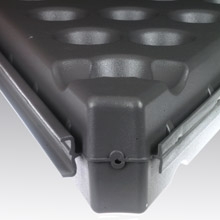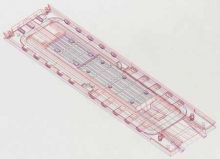
Universal Plastics is a leading provider of twin sheet thermoforming to a variety of industries. Our expertise in custom plastic manufacturing includes twin sheet thermoforming, pressure forming, vacuum forming, injection molding and blow molding and is supported by our engineering, product design & technical manufacturing know-how. Universal Plastics is also ISO 9001: 2015 registered. To discuss how Universal Plastics can meet your twin sheet thermoforming needs, please contact us.;
Twin sheet thermoforming is a plastic manufacturing process where two sheets of material are heated and formed simultaneously or sequentially into their respective molds and then quickly pressed together. While they are being pressed together, a pin is pushed through one of the sheets and air is blown in causing the sheets to be pressure formed. The heat and pressure cause the 2 sheets to fuse or seal and become a single unit where they are touching and allow the parts to be trimmed completely flush all around. This creates an extremely strong, rigid part. Products manufactured with the twin sheet thermoforming process may look similar to blow molding or rotational molding but are often less costly to form, and can be highly cosmetic.
Twin Sheet Thermoforming Process:

The top sheet is drawn into the top mold and the bottom sheet is drawn into the bottom mold. The two molds are pressure welded together at designated points around the perimeter. Twin-sheet thermoforming produces double-walled parts, panels and components. Rather than producing two vacuum formed parts, and then attaching them to each other, twin-sheet thermoforming produces both sides and joins them as one seamless unit during the forming process. This results in:
Reduced Labor Costs: producing two sides of a double-walled panel separately—then bolting, gluing or screwing them together—is reduced to a single process, eliminating an entire task from the assembly stream.
Faster Turnaround: twin-sheet thermoforming a double-walled panel is a single process that replaces three conventional processes—producing one side of the panel, producing the second side of the panel, then joining the two sides together.
Stronger Unity: since twin-sheet thermoforming joins the two halves of a part together at multiple points, the finished part is stronger and tighter than two vacuum formed sheets that have been bolted or glued together.
Stronger and Lighter than a Reinforced Single Sheet: designing geometric strength into each half of the twin-sheet thermoformed panel creates a very strong—yet relatively lightweight—panel that does not require structural supports.
Less Expensive Tooling Than Other Processes: tooling for twin-sheet thermoforming can be significantly more cost effective than tooling for other plastic molding processes such as rotational or blow molding.
Quicker to Market than Other Molding Processes: because tooling for twin-sheet thermoformed parts is simpler than tooling for other molding processes, twin-sheet parts can be put into production much faster, getting the finished product to market that much sooner.
Product Redesigns and Updates Are Easier: when parts produced through other processes need to be modified when a product is updated or redesigned, a significant investment in new tooling is required. When a twin-sheet thermoformed part needs to be modified, the existing tooling can often be modified quickly and affordably to implement the change.
Flexibility to Offer Variations of a Base Design: the tooling used in twin-sheet thermoforming can quickly and economically be modified to produce different configurations of a basic product or different models within a product line. Replaceable inserts within either mold enable changes to be made in styling features, model designations, logos or openings in the twin-sheet thermoformed part.
Two-Sided Parts: if both sides of the part will be seen by users and the public—for example, a door or hatch that opens so the inside is visible to users of the product—twin-sheet thermoforming can be used to create a double sided door with detail on both sides.
Four, Five and Six-Sided Enclosures: enclosures that need some combination of a front, a top, a bottom and one or two sides can affordably be produced using twin-sheet technology.
Strong, but Lightweight, Panels: when a panel must have considerable strength and durability, but weight is also a consideration, building geometric strength into a twin-sheet thermoformed part results in an incredibly strong, yet surprisingly lightweight, part.
Panels that House Hardware and/or Components: panels that need to support, protect and/or hide latches, locks, wiring, cables, switches, and/or electrical or electronic components are also ideal applications for twin-sheet thermoforming.
Pockets or Enclosures: the added capabilities twin-sheet thermoforming can be used to create value-added panels or housings that have pockets or enclosures. These can serve a variety of purposes, such holding manuals or operating instructions, or for the storage of tools, spare parts, accessories and/or supplies.
Panels that Need Thermal or Acoustic Insulation: thermal or acoustic insulation can be pumped into the cavity between the two sides of the twin-sheet thermoformed part.
Wide Range of Resins, Colors and Finishes: there is no limit to the combination of base materials, colors, exterior details and finishes that can be incorporated into a twin-sheet thermoformed part. The part can be produced with an inherent color in the resin, so no painting is required, or the part can be painted and/or screen printed, and the surface can be hot stamped or given other finishes.
EMI/RFI Shielding: for electrical or electronic equipment that require housings with EMI and/or RFI shielding, twin-sheet thermoforming is an affordable option. Shielding can be applied to required specifications in a secondary operation.
Whatever your twin sheet forming needs are, Universal can deliver. Contact us today for any twin sheet forming or thermoforming needs you may have.
Advantages:
Twin-sheet thermoforming can replace two processes with one, save time and labor, produce a seamless part and create a stronger structure so you end up with a lighter, cheaper component. Advantages are:
- Lower tooling cost
- Different material thicknesses
- Improved structural rigidity
- Ability to form hollow or foam-filled parts or parts with components within
- Two-color product option available
- Improved aesthetics due to tool contact on both sides
- Detailed, clean outside part and a ribbed inside
- Formable in multiple materials and sizes
Applications:
Twin-sheet thermoforming produces a double-sided, hollow panel with features on both sides of the exterior to create multi-dimensional housings and enclosures, strong yet lightweight, as housings for hardware and components, pockets or enclosures or panels that require thermal or acoustic insulation. Parts, panels, enclosures that will be seen from both sides, need considerable strength, or will house insulation, mechanical parts, or electrical or electronic components, are all ideal applications for twin-sheet thermoforming. Some end uses include:
- Large doors
- Component panels
- Shrouds & base covers
- Equipment enclosures
- Pallets
- Cases
- Dual walled flooring
- Hinges
- Containers
Twin Sheet Thermoforming Materials & Sizes:
Universal Plastics can thermoform in HIPS, ABS, TPO, HDPE, PETG and any other thermoformable material and sizes from 8” x 8” to 50′ x 80″, depending on configuration
Twin Sheet Thermoforming Capabilities at Universal Plastics:

Universal Plastics is the largest precision heavy gauge custom thermoformer in the Northeastern US with an asset base of 22 pressure formers, 14 vacuum formers and 26 5-axis trimming machines, supplying our customers with vacuum forming, pressure forming, including twin sheet forming and complex assemblies, with part sizes up to 12’ x 9’. In addition, we offer in-house tooling, an experienced engineering staff, and a full complement of secondary/finishing services, including our new state of the art paint booths which can produce automotive quality finishes. With a range of rotary formers, rapid manufacturing processes, and a global supply chain, we can produce thermoformed parts at the most competitive prices. Universal Plastics’ extensive experience designing twin sheet formed parts gives us the confidence to say we are experts in understanding the process advantages and limitations. In addition to custom thermoforming, Universal Plastics also offers injection molding (including gas assist and structural foam molding) and custom blow molding. We would be glad to talk with you about the optimal process for your needs.
For more information about pressure forming and how Universal Plastics can put our expertise to work for you, please contact us.
